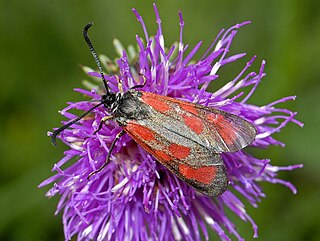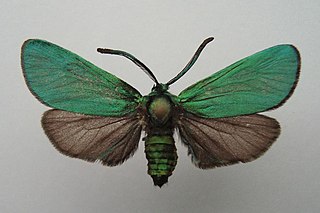
The Zygaenidae moths are a family of Lepidoptera. The majority of zygaenids are tropical, but they are nevertheless quite well represented in temperate regions. Some of the 1000 or so species are commonly known as burnet or forester moths, often qualified by the number of spots, although other families also have 'foresters'. They are also sometimes called smoky moths.

The Zygaenoidea comprise the superfamily of moths that includes burnet moths, forester moths, and relatives.

Zygaena loti, the slender Scotch burnet, is a moth of the family Zygaenidae. It is a diurnal moth characterized by a black body, light colored legs, and red spots on its wings. The caterpillars are a yellow-green color and usually molt out of dormancy in late February to early March. The larvae feed on plants from the family Fabaceae until they enter their pupal stage and mature into adults in May to early June. For mating, Zygaenidae exhibit a dual-partner finding strategy, where females use pheromones while assuming a calling position, and males exhibit a patrolling behavior where they utilize both vision and the olfactory receptors in their antennae to locate a potential mate. Although regionally endangered as their population is declining, Z. loti is found all across Europe, inhabiting areas rich in their desired food plants: lime-rich, and characterized by a hot and dry climate. The decreases in their population are likely due to factors such as habitat loss and fragmentation brought on by commercial agriculture and urbanization, as well as global climate change. There are few conservation programs currently focusing on Zygaena loti.

Adscita statices, the green forester, is a moth of the family Zygaenidae. It is found in Europe, Mongolia and western Russia.

Procridinae is a subfamily of the family Zygaenidae.

Adscita is a genus of moths of the family Zygaenidae.

Konstantin Aleksandrovich Efetov is a Ukrainian biologist and biochemist, Honored Scientist of Ukraine, Academician of the Russian Academy of Natural History, Professor, Dr. Biol. Sci., Head of the Department of Biological Chemistry and Laboratory of Biotechnology of the Crimea State Medical University.
Adscita albanica is a moth of the family Zygaenidae. It has a disjunct distribution, which included south-eastern France, Switzerland, in Italy, Slovenia, North Macedonia, Albania, Bulgaria, Greece, Ukraine, the southern part of European Russia and the Caucasus.
Adscita mauretanica is a moth of the family Zygaenidae. It is found in Morocco and north-western Algeria
Adscita bolivari is a moth of the family Zygaenidae. It is endemic to Spain.
Adscita capitalis is a moth of the family Zygaenidae. It is found in North Macedonia, Greece and Turkey.
Adscita jordani is a moth of the family Zygaenidae. It is found in Portugal and Spain.
Adscita schmidti is a moth of the family Zygaenidae. It is found on the Iberian Peninsula west of the Ebro river.

Adscita alpina is a moth of the family Zygaenidae. It is found in Central Europe.

Adscita geryon, the cistus forester, is a moth of the family Zygaenidae. It is found in southern and central Europe, east to Turkey. It is also present in Great Britain.
Adscita italica is a moth of the family Zygaenidae. It is found in mainland Italy and on Sicily, as well as in Turkey.
Adscita obscura is a moth of the family Zygaenidae. It is found in Bulgaria, the Republic of Macedonia, Albania and Greece, as well as in Turkey, Iran, Russia, Transcaucasia, Syria, Lebanon, Israel and Egypt.

Adscita mannii is a moth of the family Zygaenidae. It is found in Germany, France, Switzerland, Austria, Italy, Spain, Slovenia and the Balkan Peninsula. The range extends to north-western Turkey.









